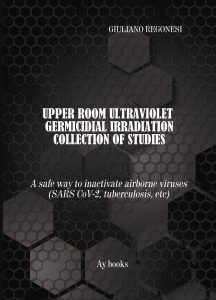
UVC RAYS
FULL FOCUS ON UV-C RAYS
NOOR transforms germicidal ultraviolet technology into a real and practical solution.
By applying safe and verified knowledge in terms of wavelengths, timing and doses, NOOR builds devices that eliminate contamination in total safety, strategically deactivating all types of viruses.
In the company mission, the constant search for solutions that improve the quality of health, daily well-being and environments, in any area.
Thanks to the use of UV-C rays, all this is now possible.
Below we will try to briefly explain the functioning of UV rays, but for an in-depth study with respect to the studies currently carried out in this field and their application in different fields as regards disinfection against viruses and bacteria – with a special focus on their effectiveness on deactivation of the Sars COV 2 virus – we recommend reading these books, written by Giuliano Regonesi, founder of the Company.


Contact us if you want to know where to buy a copy or to have more information.
What are UV rays?
What are UV rays?
Light is divided into visible rays, infrared rays and ultraviolet rays. Ultraviolet rays
(invisible) are classified into:
-UV – A (tanning properties) (315-400 nm) with tanning properties;
-UV – B (therapeutic properties) (280-315 nm) with therapeutic properties and vitamin C;
-UV – C (germicidal properties) (100-280 nm) with antiseptic properties

UV-C rays work extremely effectively, they do not create resistance and they work
against all microorganisms. They disinfect the air and surfaces of rooms in complete safety, leave no residues and allow you to avoid or reduce the use of chemical disinfectants, which, on the other hand, can release dangerous surpluses.
There are no limits to the possible applications of UV-C rays, from the domestic sector (they are used to avoid the formation of mold on the walls, to remove mites from the bedroom, to keep the air healthy inside a room, to treat water, to treat your clothes), to the industrial one (to eliminate odors, to sanitize common environments, to eliminate bacteria, viruses, fungi, spores, molds and mites by destroying their DNA and inhibiting their reproduction and proliferation).
Exposure to UVC rays destroys the DNA structure.
For this reason, exposure can kill bacteria and deactivate viruses, making them unable to reproduce
The exposure dose depends on the strength of the UVC source, proximity and exposure time.
UVCs are dangerous for humans.
(for maximum bactericidal efficacy and for your safety, rely on NOOR experts)
THE EASE OF PROLIFERATION OF THE VIRUS
Viruses, bacteria and molds, animal residues, mites, pollen are among the main causes of dangerous
infections and allergies. Each of these contaminants disperses differently; some, such as mites, bacterial spores and molds, are transported by the air, others like bacteria and viruses, “cling” to solid particles, such as the spores themselves or droplets of moisture that are inhaled by humans and proliferate easily.
In the presence of large gatherings of people, air conditioning systems, contaminated surface objects, the virus has fertile ground to grow and multiply, generating dangerous consequences.
HOW DO UV-C RAYS DISINFECT AIR AND SURFACES?
When irradiated with the use of UV-C, a strong reduction of microbes present in the air of the rooms and on surfaces is obtained. Thanks to our products, a 99% reduction of Bacillus, Coli, Clostridium, Legionella, Vibrio, Salmonella, Listeria, Pseudomonas, Staphylococcus, Streptococcus bacteria is obtained in a few minutes seconds.
This feature allows you to intervene even on areas otherwise unreachable by solid bodies such as objects and hidden areas of floors, various surfaces and furniture.
Even where the use of chemical disinfectants is mandatory, irradiating the surfaces avoids shadow areas, does not generate resistant species and can be used at any time, avoiding rapid recontamination of the surfaces and always keeping the latter in optimal conditions from a microbiological point of view.